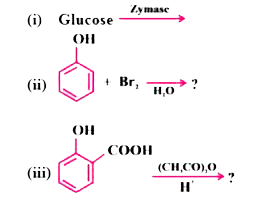CH3−OH∣CH−O−CH2−CH3HI−−→?+?
To solve the given question, let's break down the reaction step by step:
Step 1: Identify the Reactants
The reactant given is:
CH3−OH−CH−O−CH2−CH3
This compound is a type of alcohol (specifically a secondary alcohol) and an ether due to the presence of the oxygen atom connecting two alkyl groups.
Step 2: Protonation of the Alcohol
When hydrogen iodide (HI) is added to the alcohol, the hydroxyl group (-OH) can be protonated. This means that the oxygen atom in the -OH group will accept a proton (H⁺) from HI, leading to the formation of a positively charged oxonium ion:
CH3−OH+2−CH−O−CH2−CH3
Step 3: Water Elimination
The protonated alcohol can now lose a water molecule (H₂O). This step involves the removal of the -OH group as water, which leads to the formation of a carbocation:
CH3−CH+−O−CH2−CH3
Step 4: Rearrangement and Double Bond Formation
The positive charge on the carbocation can shift to form a double bond with the adjacent carbon atom. This results in the formation of an aldehyde:
CH3−C=O−CH2−CH3
This compound is acetaldehyde (or ethanal).
Step 5: Nucleophilic Attack by Iodide Ion
The iodide ion (I⁻) from HI acts as a nucleophile and attacks the carbon atom adjacent to the oxygen atom. This leads to the formation of ethyl iodide:
CH3−CH2−I
Final Products
The final products of the reaction are:
1. Acetaldehyde (ethanal): CH3CHO
2. Ethyl iodide: CH3CH2I
Summary of the Reaction
The complete reaction can be summarized as:
CH3−OH−CH−O−CH2−CH3+HI→CH3CHO+CH3CH2I
The reactant given is:
CH3−OH−CH−O−CH2−CH3
This compound is a type of alcohol (specifically a secondary alcohol) and an ether due to the presence of the oxygen atom connecting two alkyl groups.
When hydrogen iodide (HI) is added to the alcohol, the hydroxyl group (-OH) can be protonated. This means that the oxygen atom in the -OH group will accept a proton (H⁺) from HI, leading to the formation of a positively charged oxonium ion:
CH3−OH+2−CH−O−CH2−CH3
The protonated alcohol can now lose a water molecule (H₂O). This step involves the removal of the -OH group as water, which leads to the formation of a carbocation:
CH3−CH+−O−CH2−CH3
The positive charge on the carbocation can shift to form a double bond with the adjacent carbon atom. This results in the formation of an aldehyde:
CH3−C=O−CH2−CH3
This compound is acetaldehyde (or ethanal).
The iodide ion (I⁻) from HI acts as a nucleophile and attacks the carbon atom adjacent to the oxygen atom. This leads to the formation of ethyl iodide:
CH3−CH2−I
The final products of the reaction are:
1. Acetaldehyde (ethanal): CH3CHO
2. Ethyl iodide: CH3CH2I
The complete reaction can be summarized as:
CH3−OH−CH−O−CH2−CH3+HI→CH3CHO+CH3CH2I
Topper's Solved these Questions
Similar Questions
Fill in the blanks :
(i) Glucose zymase−−−→

(iv) CH3CH3∣CHOCH2CH3HI−−→?
(v) Phenol + Zn (dust) →
Phenol + Na →
(vii) R2CHOH+HCI+ZnCI2(anhydrous)→R2CHCI+.......
(viii) R−CHOH−R[O]−−→
(ix) CH3−OH∣CH−CH3SOCI2−−−→CH3−CICH−CH3+
(x) CH3−CH2−OHBleaching powder−−−−−−−−−→
View SolutionGive the star mark to the hydrogen which is most acidic in the following compounds:
(a) CH3−CH2−O∣∣C−CH2−CH3 (b) H2C=CH−CH2−O∣∣C−H
(c ) CH3−O∣∣C−O−CH2−CH3 (d) CH3−OH∣CH−O∣∣C−OH
View Solution
Knowledge Check
The molecules CH3−O∣∣C−CH2−O∣∣C−O−C2H5 and CH3−OH∣C−OH−O∣∣C−O−C2H5 are
Ageometrical isomersBTautomersCDiastereomersDMetamersIn the reaction CH3−CH3∣CH−CH2−O−CH2−CH3+HIHeated−−−→............
Which of the following compounds will be formed ?ACH3−CH3∣CH−CH2OH+CH3−CH2−IBCH3−CH3∣CH−CH2−I+CH3CH2OHCCH3−CH∣CH3−CH3+CH3CH2OHDCH3−CH∣CH3−CH2OHCH+CH3CH3The IUPAC name of CH3−OH∣CH−CH2−CH3∣CH−COOH is :−
A2− Hydroxy−4−methypentanoic acidB1−Methyl−3−hydroxypentanoic acidC4−Hydroxy−2−methylpentanoic acidD4−Carboxypentanool−2
(CH3)2−CHO∣C−CH2OH
View SolutionWhich of the following compounds gives fastest reaction with HBr and why?
(i) (CH3)3_OH (ii) CH3CH2CH2OH
(iii) CH3OH∣CHCH3 (iv) CH3CH3∣CHCH2OH
View SolutionWhich of the following is the correct ease of dehydration ?
I CH3−CH2−CH2−CH2∣OH , II CH3−CH2−OH∣CH−CH3 , III CH2=CH−OH∣CH−CH3, IV

View SolutionCH3−O∣∣C−CH2−CH2−O∣∣COCH2−CH3CH3MgBr(one mole)−−−−−−−−−−−−−→ A, A formed in this reaction is :
View SolutionThe order of stability of the following tautomeric compound is
I. CH2=OH| C −CH2−O∣∣C−CH3
II. CH3−O∣∣C−CH2−O∣∣C−CH2
III. CH3−OH| C =CH−O∣∣C−CH3
View Solution
